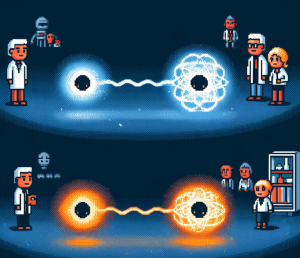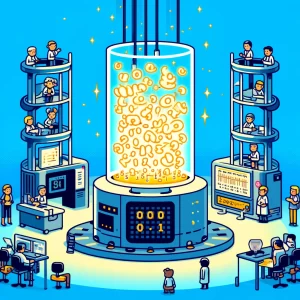
Could Quantum Tech Make Your Internet 1000x Faster?
Ever felt frustrated when your video call freezes or a download takes forever? Are you stuck wondering if someone is on mute?
Now, what if I told you the solution to your internet woes involves quantum mechanics? Yep, the same quantum weirdness that’s puzzled scientists for decades could soon give us connections so fast and precise they’d make current tech look like dial-up.
Today’s cutting-edge 5G networks have revolutionized how we connect—fast streaming, seamless gaming, and near-instant communication are now everyday expectations. But scientists are already chasing something even faster, more reliable, and precise—welcome to the future: Quantum Nonlinear Synchronization (QNS), the backbone of upcoming 6G networks.
Wait, Quantum What?
Let’s break it down. Synchronization in telecommunications is basically making sure everything speaks the same “language” at the exact same moment. Think of your favorite band playing perfectly in tune. Now imagine the drummer suddenly going off-beat—that’s your internet without proper synchronization. Current technologies like the Precision Time Protocol (PTP) do a decent job, but they’re a bit like musicians who sometimes lose the beat—leading to jitters and slowdowns.
Enter Quantum Nonlinear Synchronization, which uses atomic systems and their quirky quantum behaviors to lock timing down to a jaw-dropping level of precision. It’s like getting an entire orchestra of atoms to play perfectly in sync, ensuring your internet connection stays smooth and lag-free.
How It Works (Without the Headache)
In quantum synchronization, scientists trap atoms inside something called optical resonators (think of them as tiny atomic dance floors). These atoms interact with photons—little packets of light—and through carefully controlled “photonic pumping,” scientists make these atoms dance to a highly precise beat.
Imagine a laser sending super-precise pulses of light through optical fibers, acting like a conductor waving a baton. Each pulse is tuned to interact with thulium atoms inside special setups called optical lattice clocks, achieving synchronization at a level that was once pure science fiction—femtoseconds. To put that into perspective, a femtosecond is to a second as a second is to over 31 million years. Yep, that’s mind-blowingly precise!
Real-World Magic (and Why You Should Care)
But why do we need such ridiculously accurate synchronization? The short answer: future tech demands it. Autonomous vehicles, ultra-high-definition virtual reality, real-time surgery through remote robots—these technologies can’t afford even tiny delays.
Imagine your self-driving car deciding when to brake. A fraction-of-a-second delay could spell disaster. Quantum synchronization ensures timing accuracy far beyond what current 5G can offer, enabling the seamless, lightning-fast communication critical for life-or-death scenarios.
How It All Works (Without Making Your Brain Melt)
Here’s the quantum journey simplified:
- Atomic Dance Party: Optical lattice clocks trap atoms and measure their precise vibrations. The result? Pulses of light accurate down to femtoseconds (that’s a millionth of a billionth of a second!).
- Frequency Combs: The Time Rulers: Think of frequency combs as super-fine, ultra-precise rulers for measuring time. They take those ultra-fast pulses and translate them from the optical to the microwave frequencies—something your electronic devices understand.
- Digitizing the Magic: High-speed analog-to-digital converters (ADCs) then turn these ultra-fast pulses into digital signals your electronics can actually use. Imagine turning laser pulses into a digital beat your computer can groove to.
- FPGA Magic: Field Programmable Gate Arrays (FPGAs), the digital magicians of electronics, take these signals, filter out any noise (think static in your radio), and align timing across vast networks, keeping everything ticking like clockwork.
Quantum Wonders: From Labs to Your Living Room
Recently, researchers simulated this groundbreaking setup and demonstrated its incredible accuracy—even amidst noise and digital processing. They achieved synchronization at the femtosecond level, showcasing how QNS technology could significantly outperform existing solutions like the Precision Time Protocol (PTP), which sometimes struggles with microsecond-level inaccuracies.
In practical terms? That means your streaming won’t hiccup, your online gaming won’t lag, and life-saving tech won’t skip a beat.
From Science Lab to Your Smartphone
Though Quantum Nonlinear Synchronization is still mostly in research labs, scientists are already looking to bring it mainstream. By integrating these quantum systems with current tech like mode-locked lasers, advanced photodetectors, and FPGA-driven processors, this groundbreaking method could soon become the backbone of tomorrow’s 6G networks.
What’s Next?
We’re on the edge of a communications revolution. QNS isn’t just cool quantum science—it’s a critical step towards a world connected seamlessly by ultra-precise timing. Researchers are now focusing on making this tech resilient to noise and scalable across global networks. The future isn’t just faster; it’s quantum-fast!
Let’s Explore Together!
Ready to join the quantum leap? Here are some fun questions to spark conversation:
- How do you see this quantum synchronization tech affecting your daily life?
- What futuristic tech would you want most if your internet speed and reliability skyrocketed?
- What’s the most mind-blowing science fact you’ve stumbled across recently?
Leave your thoughts in the comments below, or share this article to see what your friends think. Let’s explore the quantum future together!
Fight for Science
The stakes for science have never been higher. In today’s turbulent political climate, staying informed is critical. Subscribe to our weekly newsletter to get the latest discoveries, major breakthroughs, and stories that matter most. Designed for teachers and science enthusiasts, this free resource enhances your teaching and understanding of science in real time. Subscribe today to ensure science stays at the forefront of public conversation! If you liked this blog, please share it—your referrals help This Week in Science reach more people when it’s needed most.



